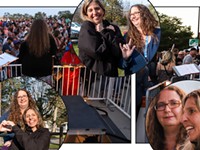[
{
"name": "500x250 Ad",
"insertPoint": "5",
"component": "15667920",
"parentWrapperClass": "",
"requiredCountToDisplay": "1"
}
]
It's fair to say that nobody knew what to expect from the First Niagara Rochester Fringe Festival before it premiered in September 2012. But when more than 6000 people showed up at Manhattan Square Park on a Thursday evening to watch inaugural headliner Bandaloop dance on the side of One HSBC Plaza, "the penny dropped," as Festival Producer Erica Fee put it. After that, thousands of people took in at least one of the 100-plus performances that went on over five days at the nearly two-dozen local venues, and more than a few local artists and performers likely found themselves wondering, "Why am I not a part of this?"
For anyone who wanted to get involved in the Fringe Festival, now is the chance. The festival will return this fall, now expanded to 10 days — September 19-28 — and it is accepting show applications now through April 12 at its website, rochesterfringe.com. What separates Fringe festivals from other events is that they are open to all manner of performing arts, and more important, there is no centralized group determining the programming. Instead, acts apply online, and the venues decide what they want to host.
Applications for 2013 opened on February 11, and according to Fee, within days festival organizers had received dozens of submissions, some from as far away as the Czech Republic. If the pace keeps up this year, Fee says she wouldn't be surprised to receive 400 to 500 submissions.
Because of that, Fee encourages would-be applicants not to wait. "Sooner is better," she says. "It's a rolling admissions process. It's like applying to college: if you wait until the last minute to apply, and there are two spots left and 10 applicants — guess what?"
A successful Fringe Festival application will have a "clear vision of what the show is," Fee says. That may start as something as brief as a synopsis, but should demonstrate a level of show-biz savvy. "How will you sell your show in the guide? Put it in brief, exciting terms that the venue can understand and grasp quickly," Fee says.
Last year, acts that stood out to venues included interdisciplinary collaborations, the mashing together of groups, and new works, Fee says. But each venue had its own preferences and processes.
Mark Cuddy, artistic director of Geva Theatre Center, says that last year Geva received about 80 Fringe applications for its Nextstage. A five-person committee went through them, trying to find what would work best for the venue; the focus ended up being on theatrical companies, both local and traveling. Although Cuddy says he is open to some dance or music performances this year, Geva's 2013 Fringe schedule will still primarily favor theater.
Cuddy gives the following advice to Fringe applicants: "It needs a hook — it has to stand out in originality. Two, you've got to be able to pull it off. We looked at some of the proposals and thought it was a great idea, but we weren't sure of what the product was going to be. Videos are great; YouTube is really helpful."
He also suggests that performers consider applying to multiple venues. "Don't put all your eggs in our basket," Cuddy says. "Some applications said only Nextstage, only Geva. We had a bunch of 'maybes,' but if we said that this is not going to fit into our repertoire here, we let people know right away so that they could find another venue."
Writers & Books was another successful venue during the inaugural Fringe Fest. Director of Development Alexa Scott Flaherty had experience with the New York and Edinburgh Fringe festivals and, along with a committee, "We were looking for pieces that had some sort of tie-in to the literary arts, but that could be in a loose and flexible way."
Flaherty's advice for new Fringe applicants is to "play; experiment," she says. "This is the chance to make the project that only you can make. You don't have to follow the rules. Pitch it from your heart and let us see what you want to create and how you plan on getting there. Remember, the original Edinburgh Fringe artists were renegades and self-enterprising. They moved away from the mainstream and did it themselves. That's the spirit of Fringe."
That spirit is what appealed to Andrew Pramuk and Alison Moritz, who with their partners presented "Hide the Moon: Based on Salome" at RAPA's East End Theatre for the inaugural Rochester Fringe Festival. At the time, both were students at the Eastman School of Music and were intrigued by the collaborative, creative opportunities provided by the festival.
"Andrew and I had worked together within the opera department, but wanted to do something less hierarchical," Mortiz says. They went to one of the "Fringe 101" information sessions to learn more, knew they wanted to do a project, but weren't sure how to proceed.
After working on all of the elements for months, both Pramuk and Moritz say the Fringe experience fulfilled their experimental goals. Pramuk says, "The play was 100 years old, originally in French. We did the English version, cut it to 20 minutes, filled it with music, had instrumentalists acting and actors singing. It was cross-disciplinary, with students fulfilling roles that weren't usual to them in their student lives. It all developed organically. It was a rewarding experience."
"Hide the Moon" was a free performance, and the group putting it on generated funds to support the project through the crowd-sourcing fundraising website Kickstarter.com. Figuring out the financial aspect of a Fringe performance is important. While applying to Fringe is free -- and you can apply as many times as you like -- if your show is accepted by a venue, there are costs associated with participating in the festival. The festival — a nonprofit corporation — charges a registration fee of $100 to $150, and also takes 10 percent of box-office receipts to cover operation costs. The rest of the ticket price is split between venue and performer via differing cost-sharing agreements.
Linda Starkweather was another performer at the inaugural Rochester Fringe. Her "Traveling With a Broken Compass" played at the Geva Nextstage to two mostly full houses, with tickets costing $15. And yet Starkweather says she concluded her first Fringe experience losing money after paying for application fees, rehearsal fees, insurance costs, promotional materials, and a lighting professional. However, she still sees it as a positive experience overall, because it gave her a "kick in the pants" — she created the show expressly to participate in Fringe.
"I now have a show," she says. "The weekend after Fringe I performed at Cobblestone in Farmington, and the proceeds from that got me above water. The motivation from that got me on my feet, and it was a great launching pad."
Her advice to prospective Fringe performers is to "keep it simple. Make it about your performance," she says, and keep your costs low.
Festival Producer Fee agrees with that advice, and says that, "No one's performing at Fringe to come home with bags of cash. You might. What many people are doing is putting new work in front of the public, to help develop it."
Fee encourages performers to "put your independent producer hats on when negotiating contracts with venues," she says. Just because a venue offers a primetime slot, that might not be the right space for you. Perhaps it's too large, or not as keen on your act as another venue. And make sure that when the time comes, you're getting the word out. "PUSH Physical Theatre and 'The Bicycle Men' were out marketing their shows during the festival with pop-up street performances. That can affect the bottom line," Fee says.
Fee says the festival will again bring in big headlining acts, and those should be announced in May, with the entire festival schedule revealed in mid-July.
Latest in Culture
More by Eric Rezsnyak
-
“Doctor Who” Series 8: “Into the Dalek”/“Robot of Sherwood”
Sep 7, 2014 -

“True Blood” Series Finale: “Thank You”
Aug 24, 2014 -
“Doctor Who” Series 8, Episode 1: “Deep Breath”
Aug 24, 2014 - More »




